|
THE MANY HATS OF ALLAN RAE

A Birthday Greeting
by ENDRE ANARU
(Phoenix, British Columbia 49°06'00.0"N 118°34'58.8"W)
Rae, of course, is regarded as one of Canada's most striking young composers. [Note 1]
HATS
The glory of the head is sometimes in its hat: Baigneuse, Balzo, Barrett, Bicorne, Bonnet, Bowler, Carbonari hat, Capote, Chimney-pot hat, Cowboy hat, Cowl, Fez, Hennin, Homburg, Paon, Petasus, Phrygian Cap, Rembrandt hat, Skull cap, Top hat, Trilby, Turban, and Wimple, to name a few. [Note 2]
Mere decoration, a hat is it not.
Until the 1960s, the article of clothing that performed the most important role in indicating social distinctions among men was the hat. [Note 3]
And so the dictionary defines the idiom 'to wear many hats' as 'to have many jobs or roles'. [Note 4] I suppose it can mean that by donning different head coverings, someone has changed roles, changed professions, changed activities.
The Canadian composer Allan Rae has worn many hats. [Note 5] In celebration of his birthday, I'd like to talk about a few of them.
The future musician was born in the town of Blairmore, Alberta, at the foot of the Rocky Mountains, with the vast prairie stretching towards the rising sun:
https://en.wikipedia.org/wiki/Blairmore%2C_Alberta
Coordinates: 49.6081°N 114.4428°W
As a young man starting out Allan Rae played trumpet in the Crowsnest Pass Band, taking lessons from local bandmaster, Frank Edl. At sixteen Rae was chosen as one of 35 musicians to play in the Rose Bowl Parade in Pasadena, California.
In 1960, after high school, Allan Rae joined the Canadian Army and was 'member of the Lord Strathcona Horse Army Band under the baton of Captain F M McLeod.' [Note 6] [Note 7]
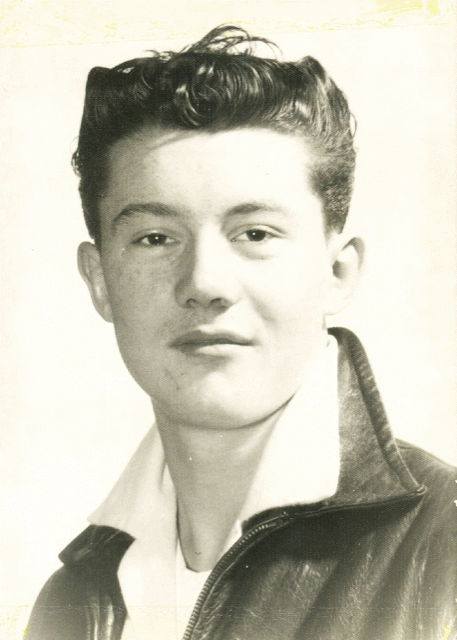
Allan Rae, circa 1960
|
To make the best possible music he purchased a beautiful trumpet. It is:
A Schilke B1 from 1961, and was a very rare and expensive instrument in its time. One of it's rarer features is a conical lead pipe that tapers toward the mouthpiece, resulting in a warmer fuller sound. [Note 8]
When his military service was over in 1963, still wearing the trumpeter's hat, he took himself to Boston [Note 9], where he studied at the Berklee School of Music. [Note 10]
Founded by Lawrence Berk in 1945 (under the name of Schillinger House) and since has changed its name occasionally, it is now known as the Berklee College of Music and is 'the largest independent college of contemporary music in the world'. [Note 11] This was the place to study jazz and contemporary (as opposed to classical) music with active professional musicians.
Again, he studied a wide range of subjects and did very well:
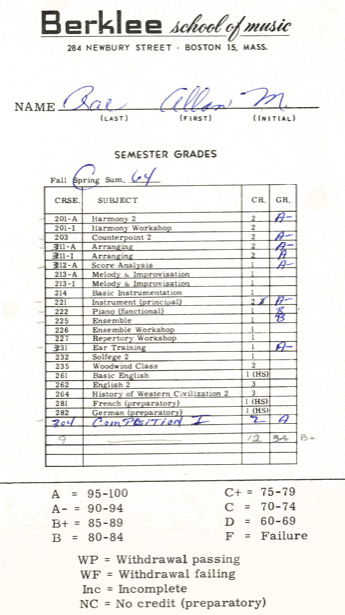
Allan Rae's subjects and grades
from the Berklee School, 1964
|
Numerous works were composed and performed. For example, his Sonata for Cello and Piano was performed by Patricia Siekman and Michael Rendish Tuesday, 11 May. [Note 12] On 16 March 1965, Rae's Quartet No 1 (for trumpet, alto sax, and two trombones) was performed at the Brookline Library Music Association Composer's Workshop. But the hat was a jazz hat.
JAZZ BAND LEADER
Upon his return to Calgary after the completion of his degree in 1965 [Note 13], Allan Rae organized and presented jazz ensemble concerts in Calgary.
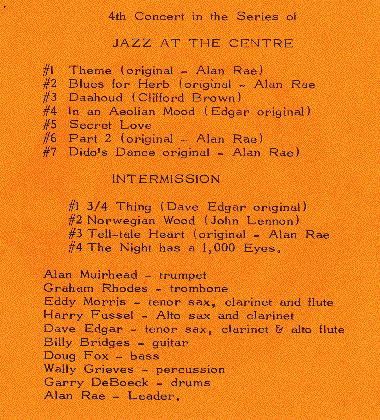
Sample Programme from Calgary (n.d.) [Note 14]
|
He was very highly praised:
Rae's compositions show great originality, with complex rhythms and big band treatment ... Rae's arrangements of Summertime and Winterwonderland [sic] further demonstrate the young composer's ability to structure sound the way he feels it should be. [Note 15]
His success was not just local. In 1966 and 1967 he won composition awards from the 'International Jazz Festival' in Prague. [Note 16]
Rae 'arranged, conducted and performed on the CBC's weekly radio jazz feature, Calgary Beat, as well as the TV variety show, Je m'appelle Micheline.' [Note 17] But soon, that hat didn't quite fit, and he donned another: composer of musicals.
MUSICALS
History is already fading from most people's minds, so it is likely little recalled that the 1960s 'Summer of Love' turned horrifically into the madness of 'Helter Skelter'. [Note 18] Rae worked on a show based on the murderous rampage of Charles Manson. Titled 'Charles Manson: a k a Jesus Christ', the work was texted in part upon the official trial transcripts and interviews. Written by Fabian Jennings, it received striking reviews in numerous productions. [Note 19]
But, this was not the only show. As it typical of Rae's prolific creativity, he also composed music for these as well, around this time:
Beware the quickly who;
Where are you when we needed you, Simon Fraser?;
You Two Stay Here, the Rest Come with Me; [Note 20]
Trip.
Aside #1: The brief mention of rock music, should not prevent us from forgetting that that style of music also appears in Allan Rae's hat assemblage. We even find him adjudicating a competition for folk and rock bands. [Note 21]
Aside #2 Oh, and at some point Allan Rae wrote reviews of records. [Note 22]
ELECTRONIC MUSIC AND MUSIC COPYING
But, even this did not appease his inner hunger. He said:
But there was something missing. I enjoyed writing and performing jazz, but it wasn't enough. [Note 23]
In 1970 Allan Rae took his family to Toronto where he studied electronic composition with the renowned Samuel Dolin [Note 24] for four years at the electronics studio of the Royal Conservatory.
But, he was not a cult member. He said:
The whole problem with electronic music has always been the gimmicks ... [Note 25]
It is not known what works he composed in this period. But, four years in the life of Allan Rae, with a very decided hat for electronic music, would lead one to believe that there were many works created. Many, for Allan Rae never does things by halves. Sadly, these works are lost. [Note 26]
Along side these years of studies, he worked as a music copyist for the Canadian Music Centre. That does not mean he duplicated CDs and posted them online. I am appalled at the lack of knowledge that modern people possess. Music copying is the process of turning the composer's handwritten score into something legible by a musician. In some cases this is a wide gulf. In days past this could be done by hand using a variety of pens and rulers and Rae's hand was clear and beautiful. Here is a sample of one of his compositions, for 2 trumpets, from 1972 (the era under discussion) and in his own copyist hand. A modern computer engraved version is also given. And finally, as a special bonus, here also is a recording of this very work:
Things to Play on a Boring Day (13 Duets for 2 Trumpets):
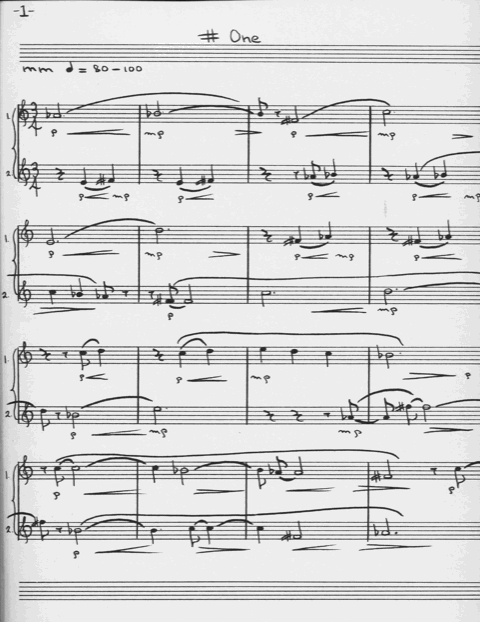
#1 Hand Made Copy by Allan Rae
(Used with permission of the Composer)
|
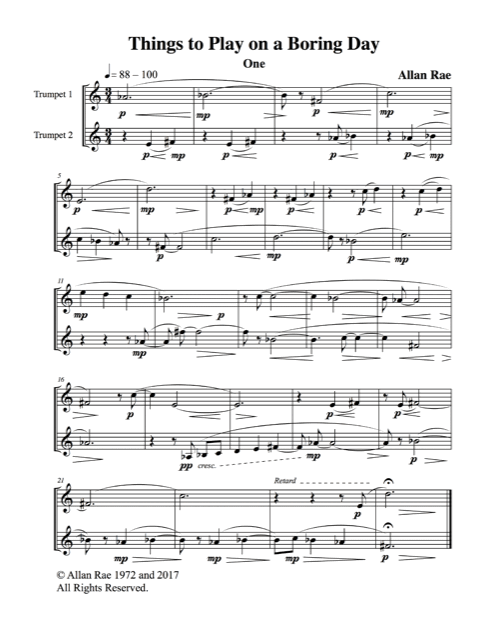
#1 Computer Engraved Version
(Used with permission of the Composer)
|
A computer generated audio version [Note 27]:
This beautiful opening duet is not a jazz work. Rather, while it evidently is based upon Rae's vast experience with the trumpet which was so much in jazz, and it is musically built on the whole tone scale and ventures through that vague realm. The duet begins with a simple major second which gradually expands, and which increases in rhythmic complexity. The structure is precise and effective. The other works in the set are equally unique and beautiful.
It may seem that music copying is a drudge task, but it was actually highly recommended by no less than the great teacher Nadia Boulanger. She herself followed her own advice and copied out hundreds of scores. By this means one learns every single note, every single marking, every single compositional method that the composer wrote or used themselves. The result can be a deep insight into the workings of the composition and the composer's mind. Rae said:
I've had some violent reactions to some of the things l've copied. I could scream when composers lay out rules for themselves about the way they have to write the piece. Once the rules are laid out, there's no room for anything of themselves, the piece becomes a formula. At the other extreme, l've copied pieces where the composer tells the musician, 'Do anything you want!' lf they have to depend almost totally on the performer's ability, they shouldn't claim to be the 'composer'. My education in the past three years has been incredible because of copying these extremes. And, out of all of it, I think, l've been able to develop my own style. [Note 28]
It might seem that this is something of a contradiction because of Rae's background in jazz, but there are many things given in jazz and not all is free form at all times. Nor should it be forgotten that Allan Rae wrote a book on improvisation. [Note 29]
Toronto may have been a vivid place for the young composer. But, again, it was time to change hats.
CLASSICAL MUSIC COMPOSER
The Allan Rae who left Calgary in 1970 to study composition had no specific idea of becoming a classical composer.
[Note 30]
Calgary beckoned in 1974 and he returned, placing the hat of a serious classical composer upon his head. He had written a symphony in 1972 with the subtitle of 'In the Shadow of Atlantis'. (Two more symphonies were to follow.) He quickly began receiving numerous commissions for concert works.
There is a vast range of his works for various ensembles that fall into the category of classical concert music. Many have evocative titles, some are based upon literary sources, others nature (like the Chinook winds of Alberta). There are separate individual concerti for harp (1976), double bass (1977), piano (1979), violin (1979), and trumpet (1996); works for chamber ensembles of widely varied formulations, numerous piano works, and even a few works for chorus. Many works are slow to develop, contrasting peaceful and active sections, structured by overlaying addition of material followed by its subtraction to reflective conclusions. The deep spirituality of Rae's soul is present at all times.
Here is an mp3 of a computer generated version of Allan Rae's Concerto for Trumpet 'Tú hablas muy bien' (1996) as arranged for trumpet and two pianos, by A N Other:
For those interested, here are also the first twelve pages from the score:
ALLAN RAE: CONCERTO FOR TRUMPET (PDF, SAMPLE)
Rae has composed one opera properly so defined, being C33 (1988) with a libretto by Denise Coffey, and for those who will notice (I didn't), the title is the cell number that Oscar Wilde was confined to. [Note 31] Nor should one forget the vast dance drama with poem cycle and drama by Fabian Jennings entitled Like Gods, Like Gods Among Them, composed in 1973. [Note 32]
One of Rae's favourite instruments is the harp. He was close friends with the eminent (and sadly late) harpist Carrol McLaughlin. She performed several of his works at Carnegie Hall. [Note 33]
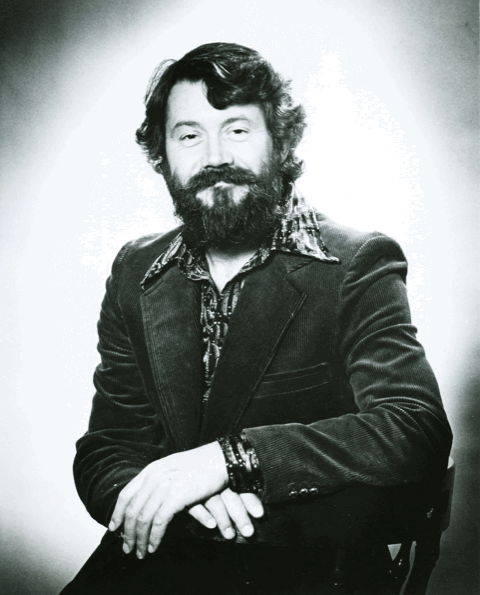
Allan Rae (ca 197?) (Used with Permission)
|
While many of Rae's works have been performed, it is with sadness that I must mention that too many (but far from all) of these works await their first performance or recording. Most pressing for this task among these are the vast symphonic works, which include more than the three numbered symphonies. [Note 34]
Rae was constantly experimenting and absorbing ideas and techniques, though without slavish adherence. He said:
I have tried most everything available to the contemporary composer: tape, electronics and serialism among them. Now I prefer to work between extremes, using none of these procedures exclusively, but only as additional tools to build my work. It opens up more areas to me than ever before and I can approach each new work with anticipation and excitement. [Note 35]
The piano is also important to Rae, for he has played keyboards often, a remarkable number of his works include the piano. One of his giant pieces is Alam Al Mithal :
To my mind the finest work of the festival had to be Allan Rae's Alam Al-Mithal for piano, played by the brilliant Calgary pianist Gloria Saarinen. The subject is the godhead of a mystical land in Herbert's novel Dune. The strong music was atmospheric in the deepest sense, with a mystical, thickly textured fabric. Saarinen made the piano her servant with wide statements and crystallized dynamics. [Note 36]
FAMILY LIFE AND ODD JOBS
Allan Rae had married his youthful sweetheart from the Crowsnest Pass, Darlene. She has worked as a realtor for many years and has always been Allan Rae's most devoted supporter. Of course, family life beckoned, as did the need for cash. In the late 1970s Rae trained as a bobcat operator, though it is not certain what type of head gear that involved. There were, as can be imagined, difficult times.
Until next fall, one of Calgary's most frequently commissioned and performed composers has abandoned music for odd jobs in construction and a guarantee of a steady income and a measure of personal pride. He will then return to school, thanks to a grant from Alberta Culture, and study toward degrees that will enable him to teach. [Note 37]
Fortunately, this period did not last long, nor was it the norm. Instead, Allan Rae found a more congenial hat.
MUSICAL THEATRE
With a fine sequence of theatrical compositions behind him (and some movies too [Note 38]), it was natural for Allan Rae to begin creating music and soundscapes for theatre. He worked on a huge number (some 200?) of major plays across Canada and for the most prestigious companies, producers and directors, in the most demanding repertoire. For example, he provided music for T S Eliot's Murder in the Cathedral at the 1988 Stratford Festival in Ontario. There is a vast field of investigation to be done here. But, there is no question about the quality of his contribution, as one critic praised 'Allan Rae's exquisite and unearthly sound effects.' [Note 39]
CAPTAIN, FATHER AND GRANDFATHER
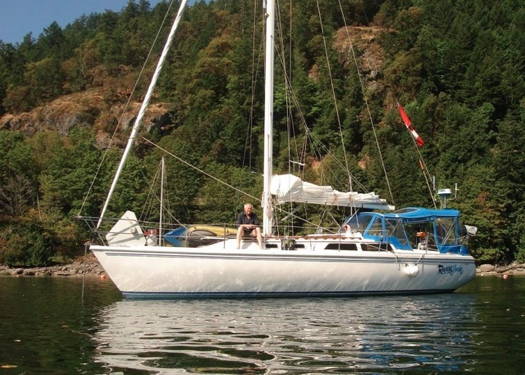
Allan Rae on Deck (© Allan Rae. Used with Permission)
|
But, one hat was quite different: it is a Captain's hat. For Rae was an avid sailor, has owned one boat or another on the West Coast of Canada for forty years, sailed to far distant lands, operated tours, taught celestial navigation and seamanship and with ardent fearlessness of the worst storms, knew that he would never die at sea.
He is also a father and grandfather and leading up to Christmas can be found decorating gingerbread houses in vast array.
Many hats. Indeed. Many skills, many characters, many activities, and so much creativity. Here is a man. And so too, here is a composer. Truly, he has been called 'Canada's most impressive composer of serious music.'
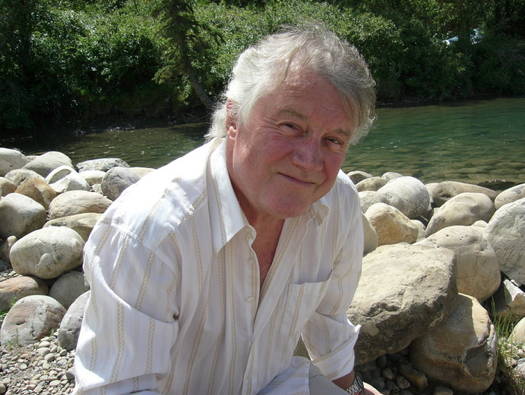
Allan Rae in Calgary, circa 2017
(© Allan Rae. Used with permission)
|
Acknowledgements
I would like to thank Allan Rae for making available to my research assistant his personal press clipping files, musical scores, recordings, photographs and conversation that allowed the data of this article to be collected. His support has been epic.
Thanks are due to John Reid, Director of the Canadian Music Centre, Prairie Region and staff of the Centre over the years for collecting information and data, and providing access to the Centre's collection of press clippings, recordings and scores.
I suppose thanks should go as well to my research assistant, g rumson. Errors in footnoting are his.
Warning to the reader who has come this far
Future articles will deal in detail with Allan Rae's music.
About documents used here
These documents and programmes are used here in the spirit of fair use for the sake of comment and criticism.
Copyright © 3 July 2018
Endre Anaru, Phoenix, British Columbia, Canada

Endnotes:
1 Jamie Portman, 'On Entertainment: Original ballet to be staged at Flare Square', Calgary Herald (n.d.)
2 Ludmila Kybalová, Olga Herbenová and Milena Lamarová, 'Headgear', The Pictorial Encyclopedia of Fashion, 1968, pp 361-366
3 Diana Crane, Fashion and Its Social Agendas: Class Gender, and Identity in Clothing (University of Chicago Press, 2000). This excerpt from http://www.press.uchicago.edu/Misc/Chicago/117987.html
(Accessed 25 June 2018)
4 https://www.merriam-webster.com/dictionary/wear%20many%20hats
5 But, I don't have pictures of him with those hats. We are in the realm of metaphor. BTW: The metaphor of the hat was heard by my assistant mentioned by Allan Rae himself, and also appears in the article by Michael Asti-Rose 'From Coal Mines to Concertos', Western Living, October 1980, p 26 ff
6 https://www.thecanadianencyclopedia.ca/en/article/bands-emc/
(Accessed 27 June 2018)
7 This information derived from an article in Allan Rae's personal press clippings file. It is given the indication 'Blairmore (CNP Bureau)'; the newspaper source has not yet been identified, but is probably the Calgary Herald.
8 Description by Adrian Rumson. Email 27 June 2018. The beautiful instrument is now in the possession of the jazz trumpeter and classical composer Adrian Rumson.
9 Yes, Boston. The name sounds too much like the San Francisco Bay area city of far greater 1960s fame for anyone's good — or anyone's clarity of thought.
10 Rae had completed a twenty-five-lesson correspondence course from the school and received his diploma on 12 June 1963. He had studied Modern Harmony, Improvisation, Arranging and Dance-Band Orchestration. The diploma is found amongst the press clippings.
11 Berklee College of Music, Wikipedia, https://en.wikipedia.org/wiki/Berklee_College_of_Music#Berklee_School_of_Music_(1954%E2%80%9370) (Accessed 27 June 2018)
12 Details of this work, and even its style, are not known at present. Tuesday fell on 11 May in 1965.
13 Or 1966, depending on sources.
14 Most of the lead sheets and certainly all of the parts for Allan Rae's works are lost. I believe that one or two of the titles exist in the surviving lead sheet collections.
15 George Lyttik, 'Rae's compositions highlight jazz concert', Calgary Herald (n.d.)
16 Suite of Modes (1966) and Sleeping Giant (1967). Scores of these are not known to the author at present. I wonder if they can be found in Prague?
17 Micheal Schulman, 'It All Began With a Trumpet: Allan Rae develops craft from copying scores', Musical Scene, July-August 1974, p 7
18 The best book on the gruesome subject remains Helter Skelter: The True Story of the Manson Murders (1974), written by Vincent Bugliosi and Curt Gentry. The reason is simple: Bugliosi acted as prosecutor for the case.
19 It is not known to the author if a full score of this project survives. Although the subject does not appeal to me, as I find the events horrifying, it is still part of history and must be considered. I leave it to others to investigate a work, as described by the critic Urjo Kareda, where 'The extensive crucifixion ritual is an ingeniously modulated blend of rock music, blasphemy, real religious grandeur, nudity, eroticism, and the bizarre'. This is quoted in Jamie Portman, 'November miscellany', Calgary Herald (n.d.). What more could modern audiences wish for?
20 This was remounted recently, as have many others. But, I leave this research to another author.
21 George Russell, 'Festival Mood More Subdued: Rock Groups "Amplify" Efforts', Calgary Herald (n.d.)
22 There is a clipping titled 'Allan Rae's Guide to the Current Pop Scene' and it includes discussion of records by Glen Campbell, Buddy Rich, Less Reed and Tom Jones. As the clipping is unidentified, it is germane that to know that Campbell and Jones released the albums mentioned in 1970.
23 Micheal Schulman, op cit, p 7
24 Samuel Dolin taught a large roster of important composers and founded the electronics studio in Toronto. See: https://en.wikipedia.org/wiki/Samuel_Dolin
25 Eugene Chadbourne, 'What's this man doing? He's composing music; that's what he's doing!' Calgary Herald Magazine, Friday 8 November 1974.
26 That is, the recording tapes of the many works created in Toronto were all discarded.
27 Created using a variety of software.
28 Micheal Schulman, op cit, p 17
29 An Approach to Improvisation. From Controlled Interpretation to Improvisation of Abstract Ideas in Contemporary Music. Unpublished. 1975. An edition is planned.
30 Eric Dawson, 'Composer commutes from pop to classical,' Calgary Herald, (n.d.)
31 It is interesting that Allan Rae has not composed any examples of lieder, to my knowledge.
32 I believe a suite for orchestra was drawn from the larger score.
33 Reviewed in the New York Times, 4 June 1978. Peter G Davis wrote: 'Mr Rae's piece exploits all the things a harp can do best, without resorting to clichés'.
34 The major works needing (no, demanding) performance and recording are Symphony No 1 (1972), Image (1975), Crack in the Cosmic Turtle for orchestra and jazz group (1975), Symphony No 2 (1978), Symphony No 3, 'Alam Al Mithal' (1980 — originally for solo piano), Transitions (1993, for chorus and orchestra), Standing Stones (1995), Take Back to Ring (2001), and neither last nor least, Celebration of Spring (1998). The outpouring of creativity exemplified in this incomplete list is enormous.
35 Eric Dawson, 'Composer commutes from pop to classical,' Calgary Herald, (n.d.). Mr Rae told the research assistant that he had even made use of the Schillinger System of music composition in several efforts, though he found the rigidity of the method uncongenial. The Berklee School began as an offshoot of the influential method of Schillinger. See: https://en.wikipedia.org/wiki/Joseph_Schillinger
36 (Unknown author), (no title), Edmonton Journal, circa 1978 [from press clipping archive of the CMC]. Some minor corrections to the text are made: italics and spelling.
37 Eric Dawson, 'Composer bitter over lack of funding for creative music', Calgary Herald, Friday 16 January 1981
38 I have found reference to the following films: Mirror, Mirror (1974) (https://www.youtube.com/watch?v=cDZnwerXMaY&t=82s), From the Ashes of War (1980), A Paid Vacation (1979), Ambush at Iroquois Point, Pablo Story, Parks Overview, For Future Generations (1985), The Great Buffalo Saga (1985). This data from the Stratford Festival brochure, 1988 and Allan Rae's biography there and also IMDb: https://www.imdb.com/name/nm0705970/ (Accessed 29 June 2018). Dates provided where known.
39 Myron Galloway, 'Complex Killdeer lifts eyebrows all the way', Montreal Star, 22 April 1975, n.p.
|
|

